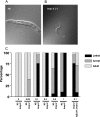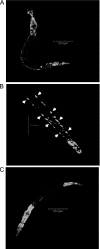Developmental arrest of Caenorhabditis elegans BRAP-2 mutant exposed to oxidative stress is dependent on BRC-1
- PMID: 20207739
- PMCID: PMC2859503
- DOI: 10.1074/jbc.M110.107011
Developmental arrest of Caenorhabditis elegans BRAP-2 mutant exposed to oxidative stress is dependent on BRC-1
Abstract
Oxidative damage by reactive oxygen species is believed to be a contributor to the development of cancer and the physiological deterioration associated with aging. In this report, we describe the effect of reactive oxygen species exposure to a developing Caenorhabditis elegans organism containing a deletion in the homolog of BRCA1-associated protein 2 (BRAP-2). A mutant containing a deletion of brap-2 was highly sensitive to oxidizing conditions and demonstrated early larval arrest and lethality at low concentrations of the oxidative stress-inducing drug paraquat compared with the wild-type. This developmental arrest occurred early in the L1 stage and was dependent specifically on the function of the C. elegans ortholog of BRCA-1 tumor suppressor brc-1. We also show that developmental arrest in brap-2 mutants when exposed to oxidative stress was due to enhanced expression levels of the cell cycle inhibitor cki-1, and this increase in the expression levels of cki-1 requires brc-1 in brap-2 mutant animals. Our findings demonstrate that BRAP-2 is necessary for preventing an inappropriate response to elevated levels of reactive oxygen species by countering premature activation of BRC-1 and CKI-1.
Figures




References
-
- Burhans W. C., Heintz N. H. (2009) Free Radic. Biol. Med. 47, 1282–1293 - PubMed
-
- Martindale J. L., Holbrook N. J. (2002) J. Cell. Physiol. 192, 1–15 - PubMed
-
- Steele R. J., Thompson A. M., Hall P. A., Lane D. P. (1998) Brit. J. Surgery 85, 1460–1467 - PubMed
-
- Thompson D., Easton D. F.the Breast Cancer Linkage Consortium (2002) J. Natl. Cancer Inst. 94, 1358–1365 - PubMed
Publication types
MeSH terms
Substances
LinkOut - more resources
Full Text Sources
Research Materials
Miscellaneous

